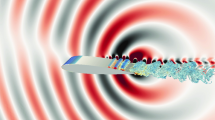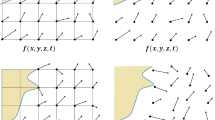Abstract
Detached-eddy simulation (DES) is well understood in thin boundary layers, with the turbulence model in its Reynolds-averaged Navier–Stokes (RANS) mode and flattened grid cells, and in regions of massive separation, with the turbulence model in its large-eddy simulation (LES) mode and grid cells close to isotropic. However its initial formulation, denoted DES97 from here on, can exhibit an incorrect behavior in thick boundary layers and shallow separation regions. This behavior begins when the grid spacing parallel to the wall Δ∥ becomes less than the boundary-layer thickness δ, either through grid refinement or boundary-layer thickening. The grid spacing is then fine enough for the DES length scale to follow the LES branch (and therefore lower the eddy viscosity below the RANS level), but resolved Reynolds stresses deriving from velocity fluctuations (“LES content”) have not replaced the modeled Reynolds stresses. LES content may be lacking because the resolution is not fine enough to fully support it, and/or because of delays in its generation by instabilities. The depleted stresses reduce the skin friction, which can lead to premature separation.
For some research studies in small domains, Δ∥ is made much smaller than δ, and LES content is generated intentionally. However for natural DES applications in useful domains, it is preferable to over-ride the DES limiter and maintain RANS behavior in boundary layers, independent of Δ∥ relative to δ. For this purpose, a new version of the technique – referred to as DDES, for Delayed DES – is presented which is based on a simple modification to DES97, similar to one proposed by Menter and Kuntz for the shear–stress transport (SST) model, but applicable to other models. Tests in boundary layers, on a single and a multi-element airfoil, a cylinder, and a backward-facing step demonstrate that RANS function is indeed maintained in thick boundary layers, without preventing LES function after massive separation. The new formulation better fulfills the intent of DES. Two other issues are discussed: the use of DES as a wall model in LES of attached flows, in which the known log-layer mismatch is not resolved by DDES; and a correction that is helpful at low cell Reynolds numbers.
Similar content being viewed by others
References
Spalart, P.R., Jou, W.-H., Strelets, M., Allmaras, S.R.: Comments on the feas1ibility of LES for wings, and on a hybrid RANS/LES approach. In: Proceedings of first AFOSR international conference on DNS/LES, Ruston, Louisiana. Greyden Press, 4–8 Aug (1997)
Shur, M., Spalart, P.R., Strelets, M., Travin, A.: Detached-eddy simulation of an airfoil at high angle of attack. In: proceedings of 4th international symposium on engineering turbulence modelling and measurements, Corsica. Elsevier, 24–26 May (1999)
Travin A., Shur M., Strelets M., Spalart P. (2000). Detached-eddy simulations past a circular cylinder. Flow Turb Comb 63:293
Spalart P. (2000). Strategies for turbulence modelling and simulations. Int. J. Heat Fluid Flow. 21:252
Spalart, P.R.: Young person’s guide to detached-eddy simulation grids. NASA CR-2001-211032
Deck, S., Garnier, E.: Detached and large eddy simulation of unsteady side-loads over an axisymmetric afterbody. In: Proceedings of 5th European Symposium on aerothermodynamics for space vehicles. Cologne, Germany, 8–11 November (2004)
Mellen C.P., Frölich J., Rodi W. (2003). Lessons from the European LESFOIL project on LES of flow around an airfoil. AIAA J. 41(4):573–581
Spalart P.R., Allmaras S.R. (1994). A one-equation turbulence model for aerodynamic flows. La Rech. Aérospatiale 1:5–21
Breuer M., Jovičić N., Mazaev K. (2003). Comparison of DES, RANS and LES for the separated flow around a flat plate at high incidence. Int. J. Num. Meth. Fluids. 41:357–388
Piomelli U., Balaras E. (2002). Wall-layer models for large-eddy simulations. Ann. Rev. Fluid Mech. 34:349–374
Nikitin N.V., Nicoud F., Wasistho B., Squires K.D., Spalart P.R. (2000). An approach to wall modeling in large-eddy simulations. Phys. Fluids 12:7
Caruelle, B.: Simulations d’écoulements instationnaires turbulents en aérodynamique: application à la prédiction du phénomène de tremblement. PhD. thesis, INPT/CERFACS (2000)
Deck, S.: Simulation numérique des charges latérales instationnaires sur des configurations de lanceur. PhD thesis, U. Orléans (2002)
Menter, F.R., Kuntz, M.: Adaptation of eddy-viscosity turbulence models to unsteady separated flow behind vehicles. In: McCallen, R., Browand, F., Ross, J. (eds.) Symposium on “the aerodynamics of heavy vehicles: trucks, buses and trains.” Monterey, USA, 2–6 Dec 2002, Springer, Berlin Heidelberg New York (2004)
Batten, P., Goldberg, U., Chakravarthy, S.: LNS – an approach towards embedded LES. AIAA-2002-0427
Menter, F.R., Kuntz, M., Bender, R.: A scale-adaptive simulation model for turbulent flow predictions. AIAA 2003-0767
Travin, A., Shur, M., Spalart, P., Strelets, M.: On URANS solutions with LES-like behaviour. In: Proceedings of ECCOMAS congress on Computational Methods in Applied Science and Engineering, Jyväskylä, Finland, 24–28 July (2004)
Deck, S., Garnier, E., Guillen, P.: Turbulence modelling applied to space launcher configurations. J. Turbulence 3 (2002)
Forsythe, J.R., Fremaux, C.M., Hall, R.M.: Calculation of static and dynamic stability derivatives of the F/A-18E in abrupt wing stall using RANS and DES. In: Proceedings of 3rd International Conference on CFD, Toronto, July (2004)
Travin, A., Shur, M., Strelets, M., Spalart, P.R.: Physical and numerical upgrades in the detached-eddy simulation of complex turbulent flows. In: Friedrich, R., Rodi, W. (eds.), Proceedings of Euromech Coll. 412 “LES of complex transitional and turbulent flows,” Munich, Germany, 5–6 October 2000. Kluwer, Dordrecht (2002)
Cantwell B., Coles D. (1983). An experimental study of entrainment and transport in the turbulent near wake of a circular cylinder. J. Fluid Mech. 136:321–374
Gleyzes C., Capbern P. (2003). Experimental study of two AIRBUS/ONERA airfoils in near stall conditions. Aerosp. Sci. Technol. 7:439–449
Vogel J.C., Eaton J.K. (1985). Combined heat transfer and fluid dynamic measurements downstream of a backward-facing step. J. Heat Mass Transfer. (Trans. ASME) 107:922–929
Piomelli U., Balaras E., Pasinato H., Squires K.D., Spalart P.R. (2003). The inner-outer layer interface in large-eddy simulations with wall-layer models. Int. J. Heat Fluid Flow 24:538–550
Keating, A., Piomelli, U.: A dynamic stochastic forcing method as a wall-layer model for large-eddy simulations. To appear, J. Turb. (2006) (in press)
Caruelle B., Ducros F. (2003). Detached-eddy simulations of attached and detached boundary layers. Int. J. Comp. Fluid Dyn. 17(6):433–451
Batten P., Goldberg U., Chakravarthy S. (2004). Interfacing statistical turbulent closures with large-eddy simulation. AIAA J. 42(3):485–492
Lund T.S., Wu X., Squires K.D. (1998). Generation of turbulent inflow data for spatially-developing boundary layer simulations. J. Comp. Phys. 140:233–258
Spalart, P.R., Strelets, M., Travin, A.: Direct numerical simulation of large-eddy-break-up devices in a boundary layer. In: Rodi, W. (ed.) Proceedings of 6th international symposium on engineering turbulance modelling and measurements. 4 May 2005, Sardinia. Int. J. Heat Fluid Flow (2006) (in press)
Shur, M.L., Spalart, P.R., Strelets, M., Travin, A.: Modification of S-A subgrid model in DES aimed to prevent activation of the low-Re terms in LES mode. In: Proceedings of workshop on DES, St.-Petersburg, http://cfd.me.umist.ac.uk/flomania, 2–3 July (2003)
Wilcox D.C. (1998). Turbulence modeling for CFD 2nd edn. DCW Indus., La Cañada CA
Author information
Authors and Affiliations
Corresponding author
Additional information
Communicated by R.D. Moser
Rights and permissions
About this article
Cite this article
Spalart, P.R., Deck, S., Shur, M.L. et al. A New Version of Detached-eddy Simulation, Resistant to Ambiguous Grid Densities. Theoret. Comput. Fluid Dynamics 20, 181–195 (2006). https://doi.org/10.1007/s00162-006-0015-0
Received:
Accepted:
Published:
Issue Date:
DOI: https://doi.org/10.1007/s00162-006-0015-0




